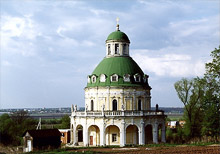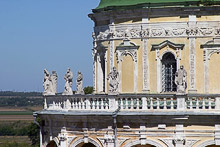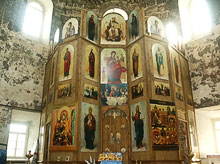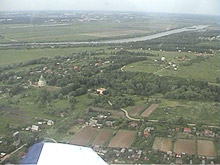|
|
The church of the Blessed Virgin's Birth in Podmoklovo
| © Jurij Solomatin |
The church of the Blessed Virgin's Birth in Podmoklovo is one of the most interesting erections of Peter's epoch that is the incarnation of west-European baroque features. A brick church delivered on the high bank of Oka represents a bivaulted rotunda covered by a high dome and accomplished by a light drum. Massive cylindrical volume of the church is surrounded by an opened arcade, connected with it by a system of groined vaults. The figures of 12 apostles and 4 evangelists are set on the axes of the arcade's pylons over the cornice on the high pedestals of the crowning balustrade. This church is one of the earliest ones that came out till now from the whole first half of XVIII century rotundas. The author of the project is unknown, but he is the Italian architect Carlo Fontano by some suppositions.
The beginning of the church's building is dated by 1714. Just at this time prince Grigory Feodorovich Dolgorukov, a senator, a plenipotentiary ambassador of Russia in Poland, starts the realization of his plan — the creation of a church-rotunda in his estate in Podmoklovo.
| © Vadim Zhitnich |
After Dolgorukov's death the estate in Podmoklovo turns to his son, a diplomat, a secret council, prince Sergey Grigorievich Dolgorukov, who continued the building of the church. But after the death of Emperor Peter II, who favoured to the Dolgorukovs and the accession of Empress Anna, the whole family got into disfavour. Prince Dolgorukov was exiled and his estates were arrested. He was executed on 26 October as a case of his participation in working up a false will of Emperor Peter II. The building of the church was stopped for a long time; it was finished by Sergey Grigorievich's son, Prince Nikolay Sergeevich Dolgorukov, the owner of the estate in Podmoklovo returned by Empress Elisaveta Petrovna. The church was sanctified in 1754. Since 1860s the estate was owned by the Vasilchikovs.
The book "Parishes and churches of Tulski eparchy" says: "It is unknown when the parish has arisen but a stone church in the name of the Blessed Virgin's Birth existing nowadays was built in 1754 with the help of the means of Prince Nikolay Sergeevich Dolgorukov and renewed in 1883 and 1893. The especially honored icon here is the icon of the Blessed Virgin "Vladimirskaya", in the name of which a religious procession is held annually on 23 June after the matins on the occasion of the rescue from cholera in 1848".
In 1915 there were a priest and a psalm reader who served in the church. The clergy bulletin for 1860, 1898, and 1915 says: "A stone building of the church with an altar in the name of the Blessed Virgin's Birth in Podmoklovo was built in 1754 by prince Dolgorukov. Instead of a wooden bell-tower arranged at the columns a stone belltower with a destination was being built at the ground floor of the church in the name of the Blessed Virgin Vladimirskaya."
During the soviet time the church was closed and used for economic needs. An outer repair was made with the help of public funds during the 1980s. Since 1993 the parish live was recommenced.
The clergy: priest Andrey Myshonkov — the senior priest
Address: Moscow region, district of Serpuhov, Podmoklovo
Thoroughfare: along the highway Moscow — the Crimea, a turn to Lukiyanovo near "105 km" post, 7 km from Lukiyanovo to Podmoklovo
Historical research
Podmoklovo
Before the XVII century the village of Podmoklovo had been reckoned in Tarussky district, then in Aleksinsky, and from 1929 in Serpukhovsky district. In the times of Ivan the Terrible iron ore was taken "from the mountain" near Podmoklovo, later white stone, called "tarussky marble", was taken from quarries right here.
The book "Parishes and churches of Tulska eparchy" says: "... the village of Podmokloe has taken its name from the flood of river Oka that inundates the constructions of this village... There is a church in the name of the Blessed Virgin's Birth in the village", that "was renewed in 1883 and 1893 years... a district school from 1870".
Before Peter the Great Podmoklovo belonged to the princes Golicyny, at the beginning of the XVII century it passed to the Dolgorukovy and was in their property till the end of the century. After the Dolgorukovy the village was owned by Tyutchevy, Peter Fadeevich and Anna Fadeevna, who married Mikhail Nikolaevich Vasilchikov. In 1840-s the village devolved to Alexander Mikhailovich Vasilchikov. The graduate of Tzarskoselsky lyceum, the lieutenant of the guards A.M. Vasilchikov was one of the richest landowners in Aleksinsky district. In 1860 he owned 126 homesteads of serf peasants (598 souls of peasants of male), over two thousands dessiatinas of acre and a broadcloth factory near Podmoklovo.
In 1894 Ryabov, the manufacturer of Serpukhov, bought the farmstead, the acres and the factory and owned the estate till 1917. As the data say there were 173 homesteads, and 1368 persons lived in Podmoklovo.
Yu. V. Bespalov
The south boundary of Moscovia (from history of Moscow district)
Puschino, 1990, p. 131
The sculptures of Podmoklovo
The church in the name of the Blessed Virgin's Birth, built in the farmstead of prince Dolgorukov in 1754, is situated in 7 km to the south-west of Serpukhov, on the right high slope of the river Oka in Podmoklovo. There is only a wing and a part of the park left from the farmstead. But the farmstead's church retained well. It is an exceptional building by design and performance. This monument has a shape of bivaulted rotunda covered with a spherical dome with lyucarnas. The church is accomplished with a massive drum. The walls of the church are brick and plastered. A white-stone decor — the carving on the pilasters — forms a relief frieze in the second circle of rotunda.
The sculpture portrayals of apostles and characters from the Gospel are absolutely extraordinary for Russian churchs. 16 white-stone sculptures with a height of 1,82 m stand located at the equal distance from each other, put on the high pedestals of the balustrade. The examination of the patterns, taken from white-stone figures in 1973-1974, has shown that the limestone from which the sculptures and decorations are made is 97-98% from tiff. The density of the stone is 2,08-2,14 g/cub. cm, the water absorption is 6,5-8,4%. This white stone is a full analogue of the limestone from myachkovsky lime-pit by its contents, structure and physical properties. That's why we can seriously say that large monoliths for the sculptures were taken to Podmoklovo from the surroundings of Myachkovo by Moscow-river and then by Oka to the place of building.
There is no other example of such a striking neglect to the resolution of the Apostolic Synod in the history of Russian architecture, which put a veto on such sculpture in the Orthodox Church in 1722. In spite of the fact that the figures were in open air for a long time, they retained the original look and have no sign of destruction. Only a thin crust of decay — a natural barrier from penetration of the corrosion deep in metal — and the remains from painting or whitewashing protected the figures from atmospheric precipitates. On account of the limestone's softness the character of the fretwork, decorating the figures, is close to the fretwork by wood. The poses and the folds of the clothes are rather plastic, the faces, fingers and toes are thoroughly trimmed, the proportions of the body are well kept up. The sculpture can't leave a person who saw these patterns of Russian stone art for the first time indifferent. There is a classical perfection of performance and a unique individuality in every statue.
If we move round the gallery clockwise, the figures of apostles Pavel, Ioann and Simon are situated to the left of the church's entrance. Further the portrayals of two evangelists Luka and Matphey are situated. Then the sculptures of three apostles — Philip, Iakov and Varfolomey follow. On the south side of the balustrade there are the statues of Maksim, apostles Andrey and Iakov. The figure of evangelist Ioann is turned to the south, after it Mark, Foma and Matphey follow one by one. The sculptural ensemble is accomplished by a massive figure of Apostle Peter with keys in his hand. A deep legend in Old Slavonic, saying who is painted, is carved at the pedestal of every statue.
Peering into the sculptural portrayals you involuntarily catch yourself on a thought that an unknown master created not the icons of the saints but of common Russian peasants only dressed into church clothes and provided with appropriate attributes of saints. At the same time each figure has its original pose and expression, depicting the features of the characters from evangelistic legends.
The sculptures from Podmoklovo take a particular place in the history of Russian art. No doubt, they perform the following step against the primitive stone figures of the church in Dubrovicy and seem to be the real sculpture carved from local material. The tenacity of the stone and its compliance to the chisel let the sculptor fulfill resolved.
L.I. Zvyagincev, A.M. Viktorov
The white stone of Moscow district. M.: Entrails, 1989, p. 95-96
R. V. Titova. The church of the Blessed Virgin's Birth in Podmoklovo and his sculptural decoration





